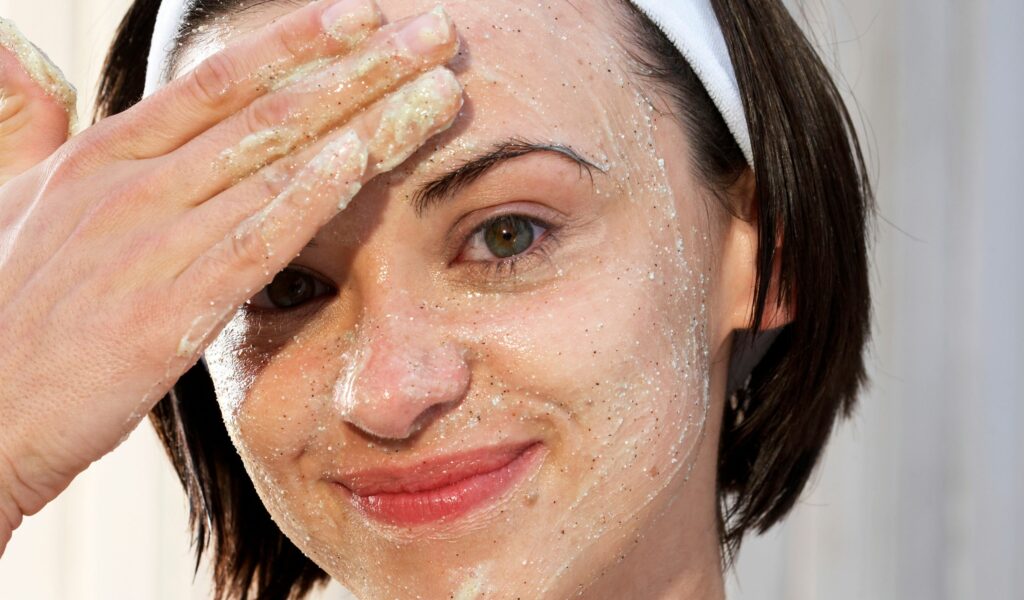
- What is the difference between AHAs and BHAs?
- What are AHAs?
- How do AHAs work, and what are the benefits of AHAs?
- FYI: AHAs can temporarily thin out the skin
- Best AHA products:
- What are BHAs?
- How do BHAs work, and what are the benefits of BHAs?
- FYI: BHAs can dry out the skin
- Best BHA products:
- How to choose between AHA or BHA for your skin
- Can you use AHAs and BHAs together?
- Best AHAs and BHAs combined products:
- The full list of best AHAs and BHAs for skin:
When you dive into the wonderful world of chemical exfoliants, things can get a little overwhelming. What’s the difference between AHAs and BHAs? Can you use AHAs and BHAs together? How do I incorporate it into my routine? That’s why we’re here! This article breaks down all the information for you, so you come out the other side with glowy healthy skin.
What is the difference between AHAs and BHAs?
Let’s start with their names…
- AHAs = Alpha Hydroxy Acids
- BHAs = Beta Hydroxy Acids
Now let’s unpack them separately. Both exfoliate your skin, but they do so in different ways.
What are AHAs?
Alpha Hydroxy Acids are naturally derived from fruit extracts like sugar cane, davidson plum, lemon and grapefruit to name a few. The most common forms of AHAs used in skincare products are glycolic acid or lactic acid. You’ll find them in various concentrations, often ranging from 5% all the way up to around 25-30%.
Because AHAs are humectants, they are best suited for normal to dry, sun-damaged skin. They have the ability to pull moisture from their surroundings, ensuring skin stays moisturised and doesn’t dry out during the exfoliation process.
How do AHAs work, and what are the benefits of AHAs?
AHAs work on two levels: the epidermis (top layer of the skin) and the dermis (the deeper layer). AHAs gently exfoliate by breaking down the bonds between dead skin cells sitting on the top layer of the skin. Once these bonds are broken, they fall off or in other words, exfoliate. Doing this smoothes out and refines skin, which makes AHAs particularly effective for conditions like minor pigmentation issues or dark spots.
One of the best benefits of AHAs though is their ability to stimulate collagen production, making it the perfect tool for reducing the appearance of fine lines. It achieves this by increasing collagen synthesis by fibroblasts (a.k.a the cells that produce collagen in the skin) and by decreasing degradation of the existing dermal matrix.
FYI: AHAs can temporarily thin out the skin
Because of the unique way it breaks down dead skin cells and helps them shed, AHAs can sometimes cause a temporary thinning of the skin. Don’t let this deter you from using it though — it’s completely normal!
This is why exfoliating should only be done around 1-2 (sometimes 3, but that’s pushing it) times a week. You must also be extra thorough with your sunscreen and SPF application, as freshly exfoliated skin without protection is a surefire way to create painful irritation and sun damage. And don’t forget to re-apply every 2 hours too.
Best AHA products:
- Paula’s Choice SKIN PERFECTING 8% AHA Gel Exfoliant
- Paula’s Choice RESIST Advanced Smoothing Treatment 10% AHA
- Alpha-H Liquid Gold (5% Glycolic Acid)Alpha-H Liquid Gold (5% Glycolic Acid)Alpha-H Liquid Gold (5% Glycolic Acid)
What are BHAs?
Beta Hydroxy Acids are best known for their acne-killing properties. The most common BHA is salicylic acid. While AHAs work on the outer levels of the skin, BHAs work on both the skin’s surface and deep inside the pore.
BHAs are oil soluble, making them an ideal exfoliant for normal to oily skin types, especially skin that’s prone to bumps, blemishes, enlarged pores and acne.
How do BHAs work, and what are the benefits of BHAs?
BHAs contain skin-calming and anti-inflammatory properties, helping to reduce redness, irritation or even alleviating conditions like rosacea.
BHAs like salicylic acid are also fat soluble, enhancing their pimple-busting abilities as it is able to deeply penetrate pores. That’s why BHAs are typically recommended for people with active acne or acne-prone skin.
BHAs work by fighting the bacteria that can cause breakouts and acne. They work similarly to AHAs, in that it breaks down the bonds that hold dead skin cells together – but also penetrate deeper to clear out the pores. Think of BHAs like a cleaning brush you’d use in a sink, deeply penetrating to remove oil and gunk that’s clogging up pores.
FYI: BHAs can dry out the skin
Because of how deeply they penetrate and reduce excess oil, BHAs can sometimes dry out the skin. The solution? Moisturise. Moisturise. Moisturise.
Best BHA products:
- Paula’s Choice SKIN PERFECTING 2% BHA Liquid Exfoliant
- Paula’s Choice BHA 9 Treatment
- Cosrx BHA Blackhead Power Liquid
How to choose between AHA or BHA for your skin
The easiest way to choose is to think about it like so:
- AHA = Best for dry, sun-damaged skin with fine lines and pigmentation
- BHA = Best for oily, acne-prone skin that suffers from redness and irritation
However, that’s a basic guideline if you don’t want to think too hard about it.
If you want to exfoliate the outer layer of your skin, AHAs are your best bet. Whereas, if you need a bit more assistance in clearing out pores and reducing breakouts, go for BHAs.
Can you use AHAs and BHAs together?
Technically, yes. You just have to be strategic about it.
The best way to use them together is by alternating between the two on different days. Alternatively, there are many products available that have been formulated to have both AHAs and BHAs. To keep exfoliation really simple, especially if it’s on the body, you could even opt for an AHA and BHA body wash.
Best AHAs and BHAs combined products:
- Paula’s Choice SKIN PERFECTING 25% AHA + 2% BHA Exfoliant Peel
- Murad AHA/BHA Exfoliating Cleanser
- The Ordinary AHA 30% + BHA 2% Exfoliating Peeling Solution
The full list of best AHAs and BHAs for skin:
- Paula’s Choice SKIN PERFECTING 8% AHA Gel Exfoliant
- Paula’s Choice RESIST Advanced Smoothing Treatment 10% AHA
- Alpha-H Liquid Gold (5% Glycolic Acid)Alpha-H Liquid Gold (5% Glycolic Acid)Alpha-H Liquid Gold (5% Glycolic Acid)Alpha-H Liquid Gold (5% Glycolic Acid)
- Paula’s Choice SKIN PERFECTING 2% BHA Liquid Exfoliant
- Paula’s Choice BHA 9 Treatment
- Cosrx BHA Blackhead Power Liquid
- Paula’s Choice SKIN PERFECTING 25% AHA + 2% BHA Exfoliant Peel
- Murad AHA/BHA Exfoliating Cleanser
- The Ordinary AHA 30% + BHA 2% Exfoliating Peeling Solution



